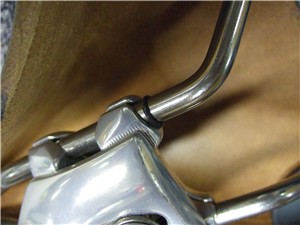
Ever had that sliding feeling? Even the most reliable of saddle rail clamps can allow the saddle to slip slowly and, in most cases, unoticeably backwards, especially if the rails are highly-polished, low friction stainless steel and the clamp is not tightened to the torque limit. This is exactly what happened to me after a recent saddle angle readjustment done with a small multi tool, but however it happens, it is annoying.
Given the importance of saddle setback with respect both to the bottom bracket (to preserve the fable Knee Over Pedal Axle measurement if used) and the handlebars (assuming reach is comfortable when the saddle is set correctly), a saddle that slides backwards (they never seem to slide forwards) could also compromise riding comfort and even efficiency, which would never do.
More often than not, the only indicator other than checking with a ruler that the saddle is no longer in its allotted place is a vague sensation of over-stretch or, worse still, of sitting low and too far back. Neither is surprising, since they are what has happened, but it can take slippage of 10mm or more before it becomes noticeable.
You might measure the bar-to-saddle reach after each ride, but this is not much use during the ride unless you are in the habit of carrying a tape measure. The answer is to mark one of the rails in such a way that slippage can be seen and, as importantly, rectified; a marker on the rail will show where to reposition the saddle if it moves.
An obvious method is to use an indelible marker pen, but there is a drawback; should you wish to reposition the saddle, you will need to add another mark and remove the first. Wrapping insulating tape around the rail will work, but it tends to unwrap over time, leaves a sticky residue and is plain awkward to use.
The ideal would be a small O ring, which would stay put but be moveable. There’s no way to get it over the rail, but it is easy to make your own version using electrical self-amalgamating tape. Used to wrap electrical joins, this stuff is generally non-adhesive but adheres to itself when placed firmly in contact. Simply snip off a small strip and wrap it tightly around the rail, maintaining tension. Do it right and you have a little ring around the rail that can be slid to where it is needed – and watched carefully…





